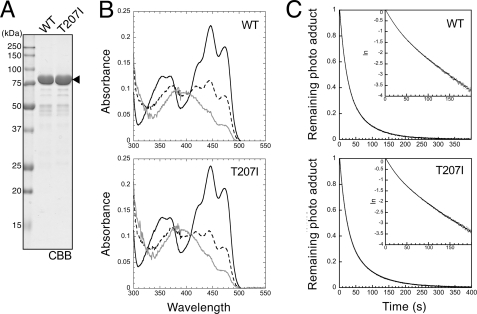FIGURE 6.
Effects of the Thr207 mutation on photochemical properties. A, 10.0% SDS-polyacrylamide gel pattern of full-length CrPHOT samples stained with CBB. The sample was prepared using the same procedures as those for Fig. 5 and was further purified by anion-exchange chromatography. The triangle indicates the position of the intact CrPHOT. B, absorption spectra of the WT and the T207I mutant CrPHOT in darkness (solid black lines) and under BL irradiation at 50 μmol m−2 s−1 (dashed black lines) and 270 μmol m−2 s−1 (gray lines). The data represent the means of three measurements. C, kinetics of the reversion of the cysteinyl adduct state to the dark state monitored by the absorption at 450 nm. The samples were equilibrated under BL at 270 μmol m−2 s−1, and the light was then tuned off at time 0. The remaining photoadduct level was calculated as 1 − (At − A0)/(A∞ − A0), where At, A∞, and A0 are absorptions at 450 nm at time t in seconds, in darkness, and under BL, respectively. The logarithm of the remaining photoadduct level was plotted against t in the inset, indicating the fast and slow components of the reversion kinetics.

